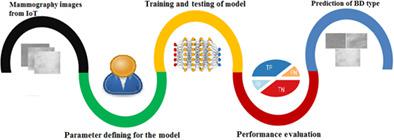当前位置:
X-MOL 学术
›
Microsc. Res. Tech.
›
论文详情
Our official English website, www.x-mol.net, welcomes your
feedback! (Note: you will need to create a separate account there.)
Internet of medical things embedding deep learning with data augmentation for mammogram density classification
Microscopy Research and Technique ( IF 2.0 ) Pub Date : 2021-04-27 , DOI: 10.1002/jemt.23773 Tariq Sadad 1 , Amjad Rehman Khan 2 , Ayyaz Hussain 3 , Usman Tariq 4 , Suliman Mohamed Fati 2 , Saeed Ali Bahaj 5 , Asim Munir 1
Microscopy Research and Technique ( IF 2.0 ) Pub Date : 2021-04-27 , DOI: 10.1002/jemt.23773 Tariq Sadad 1 , Amjad Rehman Khan 2 , Ayyaz Hussain 3 , Usman Tariq 4 , Suliman Mohamed Fati 2 , Saeed Ali Bahaj 5 , Asim Munir 1
Affiliation

|
Females are approximately half of the total population worldwide, and most of them are victims of breast cancer (BC). Computer-aided diagnosis (CAD) frameworks can help radiologists to find breast density (BD), which further helps in BC detection precisely. This research detects BD automatically using mammogram images based on Internet of Medical Things (IoMT) supported devices. Two pretrained deep convolutional neural network models called DenseNet201 and ResNet50 were applied through a transfer learning approach. A total of 322 mammogram images containing 106 fatty, 112 dense, and 104 glandular cases were obtained from the Mammogram Image Analysis Society dataset. The pruning out irrelevant regions and enhancing target regions is performed in preprocessing. The overall classification accuracy of the BD task is performed and accomplished 90.47% through DensNet201 model. Such a framework is beneficial in identifying BD more rapidly to assist radiologists and patients without delay.
中文翻译:

嵌入深度学习和数据增强的医疗物联网,用于乳房 X 线照片密度分类
女性约占全球总人口的一半,其中大部分是乳腺癌 (BC) 的受害者。计算机辅助诊断 (CAD) 框架可以帮助放射科医生找到乳房密度 (BD),这进一步有助于精确检测 BC。本研究使用基于医疗物联网 (IoMT) 支持设备的乳房 X 光照片图像自动检测 BD。通过迁移学习方法应用了两个称为 DenseNet201 和 ResNet50 的预训练深度卷积神经网络模型。从 Mammogram Image Analysis Society 数据集获得了总共 322 张乳房 X 线图像,其中包含 106 个脂肪、112 个密集和 104 个腺体病例。在预处理中执行修剪不相关区域和增强目标区域。执行并完成了 BD 任务的整体分类准确率 90。47% 通过 DensNet201 模型。这样的框架有利于更快地识别 BD,以立即帮助放射科医生和患者。
更新日期:2021-04-27
中文翻译:

嵌入深度学习和数据增强的医疗物联网,用于乳房 X 线照片密度分类
女性约占全球总人口的一半,其中大部分是乳腺癌 (BC) 的受害者。计算机辅助诊断 (CAD) 框架可以帮助放射科医生找到乳房密度 (BD),这进一步有助于精确检测 BC。本研究使用基于医疗物联网 (IoMT) 支持设备的乳房 X 光照片图像自动检测 BD。通过迁移学习方法应用了两个称为 DenseNet201 和 ResNet50 的预训练深度卷积神经网络模型。从 Mammogram Image Analysis Society 数据集获得了总共 322 张乳房 X 线图像,其中包含 106 个脂肪、112 个密集和 104 个腺体病例。在预处理中执行修剪不相关区域和增强目标区域。执行并完成了 BD 任务的整体分类准确率 90。47% 通过 DensNet201 模型。这样的框架有利于更快地识别 BD,以立即帮助放射科医生和患者。











































 京公网安备 11010802027423号
京公网安备 11010802027423号